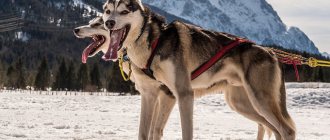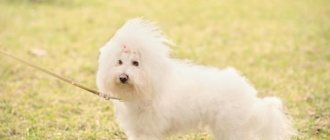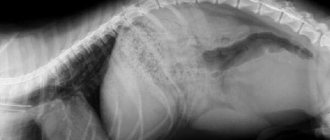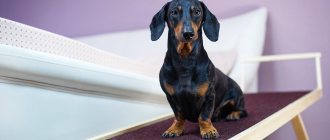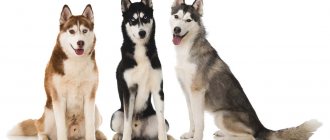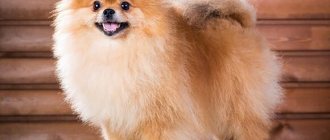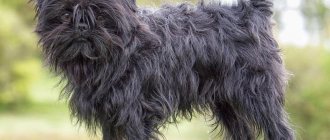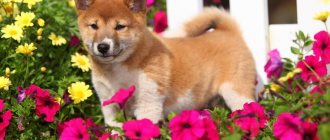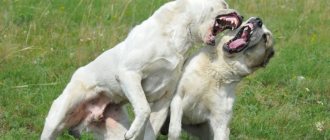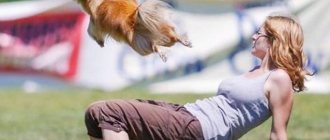Dachshunds are fearless hunters and lovely pets.
Whatever role this amazing dog plays, it will always be devoted to its owner, a brave protector, a cheerful friend, and a sweet prankster.
A dachshund can fill life with meaning and pleasure.
She understands only affection and persuasion, and is able to understand her owner at a glance and at a glance.
Violence will not achieve anything from her.
The dachshund was a favorite of many creative personalities, kings and emperors.
Origin story
Dachshunds are considered one of the oldest hunting breeds. Originally intended for badger hunting, the dog is a universal hunter - it can lead a trail and pull a wounded animal out of a swamp.
According to one version, the dachshund was bred in Germany in the 16th century from short hounds, had excellent working qualities and was in great demand, since its maintenance was inexpensive.
Another version speaks of the ancient Egyptian roots of the breed. In one of the Egyptian tombs, images of dachshund-like dogs with curved legs and a long body were found.
The world's first breed standard was adopted in 1870. , the 2001 standard of the International Canine Organization is in force for the Dachshund breed .
Dachshund character
The dachshund is the bravest and most determined dog. Capable of thinking logically and calculating her actions several moves ahead. Dogs are extremely intelligent and know how to balance their own strengths with those of their opponents.
Of the hunting dogs, dachshunds are the least likely to die or be injured.
The animals are hardy, can chase prey for hours, wander through the forest with the hunter all day, exploring side paths along the way..
The independence of dachshunds can result in the dog’s reluctance to follow the owner’s commands and even escape from him.
Therefore, letting your pet off the leash on a walk in the forest, where her ineradicable hunting instinct may flare up, can only be done with complete confidence in her control.
Dachshunds are very active and playful, they care about everything . They tend to be dominant, so from an early age the dog must learn who is boss in the house.
Breed standard and photos
Ideal proportions for a dachshund:
- the distance from the ground to the bottom of the chest is 1/3 of the height at the withers;
- The length of the body relates to the height at the withers as 1.7-1.8:1.
- Chest circumference - 35 cm;
- Weight - 9 kg;
- The head is elongated with pronounced brow ridges;
- there is no sharp transition from forehead to nose;
- The muzzle is quite strong;
- The lips are not drooping and completely cover the teeth;
- Scissor bite;
- Full teeth;
- Almond-shaped eyes, brown, blue eyes are allowed in merle-colored dogs
- The ears are drooping, long but not excessively long, smooth, not folded with rounded, not pointed edges, close to the cheekbones.
- The neck is long and strong, carried freely
- The withers are well defined
- The back is strong, strong, straight or slightly sloping.
- The croup is wide, slightly sloping
- The chest is wide, the ribs are laid back. Ideally, the front leg, when viewed from the side, covers the lower point of the sternum. This is achieved by the correct length of the shoulder blade and shoulder and the appropriate angle between them.
- The stomach is slightly tucked.
- The coat is not too fine, not coarse, without any bald patches. By type of coat there are smooth-haired, long-haired and wire-haired
- in color - single-color (all shades of red-red, fawn. There may be one or another admixture of black wool); two-color (Black or brown with red tan); marble and brindle
The purebred dachshund is a squat dog with an elongated body and short, strong legs..
Distinguished by the proud carriage of the head with the attentive gaze of intelligent eyes. The dachshund should not appear too heavy or frail, like a weasel animal. Her movements, despite her short legs, are smooth and energetic.
Based on size, the breed is divided into three varieties:
- Standard.
- Miniature (dwarf).
- Rabbit.
The breed standard is valid for all types of dachshunds.
They differ only in size. All measurements are taken at least 15 months of age.
| Types of dachshunds | Bust | weight |
| standard | 35 cm | 9 kg |
| miniature | 30-35 cm | 4.5-6 kg |
| rabbit | 30 cm | 2.5-3 kg |
Smaller copies of the dachshund were bred in Germany at the end of the 19th century specifically for hunting small burrowing animals. The credit for the appearance of these varieties goes to Dr. Friedrich Engelmann.
Miniature dogs were obtained when small specimens of standard dachshunds began to be selected for breeding work . In 1905, there was already a club for fans of miniature dachshunds, which received its name of the same name.
Dwarf and rabbit dachshunds retain all the hunting qualities, habits and habits, character traits characteristic of standard dachshunds.
According to the type of coat, dachshunds are divided into::
- smooth-haired,
- long-haired,
- Wire-haired.
In a smooth-haired dachshund:
- the body is covered with short, thick hair without bald areas;
- on the tail the hair is sparser. May be elongated on the lower part of the tail.
In long-haired:
On top of the dog’s body, the fur fits tightly and lengthens downward. The fringe hangs beautifully on the ears.
- the back of the legs is decorated with fringes;
- the tail boasts the longest hair.
In the wire-haired:
- the wool is rough, wire-like. There is undercoat. The length of the hair on the entire body is the same. On the ears it becomes flattened and short. The variety is characterized by the presence of a beard and shaggy eyebrows;
- The tail is dressed evenly and tightly.
General appearance and ratio of body parts according to the standard
According to the standard, the dachshund is characterized as a squat, short-legged dog with an elongated, but at the same time compact body structure. They are very muscular, the head carriage is bold and defiant. Well-defined sexual dimorphism is observed. Despite this body structure, all types of dachshunds (see photos in our material) are very mobile and flexible.
The breed standard assumes several important characteristics regarding the relationship of body parts. Thus, the lowest point of the chest should be located at a distance of 1/3 of the height of the withers above ground level. In addition, the oblique length of the body should be harmoniously related to the height of the withers, approximately 1.7-1.8 to 1.
Basic colors
Single color:
- red (the most valuable),
- brown (chocolate),
- all shades of red,
- pale yellow,
- sand.
White markings, small and in very limited quantities, are not a defect in the breed . But still the presence of white is not desirable.
Black color may be present in the color as a minor impurity. The nose and nails of dogs of the same color should preferably be black.
Two-color:
- black and tan,
- brown and tan.
Tan can be red, reddish-brown, fawn . Extensive scorch marks are not welcome.
Black dachshunds have nails and nose that match their color. In chocolate dogs, these exterior elements are possible in brown.
Marble
With a merle color, the main color is black, red or gray, on which small gray or beige spots are randomly scattered.
A predominance of light or dark color is not allowed.
Brindle
Red or fawn with darker stripes.
Photos of unusual dachshunds
- There are completely white dachshunds without a single spot of another color. Only her nose and claws remain black. Not recognized as a standard.
- Dachshunds with boar coloring. Recognized as a standard only for the wire-haired variety. In Russia, the boar color of smooth-haired individuals is not an obstacle to participation in exhibitions.
- White spotted dachshunds. Large, mostly dark spots of different colors are scattered throughout the main white color. The claws and nose remain black.
- Double marbled dachshunds. Large white spots are combined with smaller dark ones of different shades. Sometimes the spots completely cover the main color, sometimes there are only a few spots. This color may have red tan marks. The color is elegant, but such dogs can be blind or deaf from birth. Not recognized as a standard.
- Very rare sable color. The wool is colored unevenly. The fur at the root is lighter, and towards the end it is more richly colored. There may be some black on the ears and back.
Separation by color
Dachshunds are divided not only by size and type of coat, but also by color.
The classic color of the dachshund, known throughout the world, is black and red. It comes in solid, marble, tan and brindle. The wire-haired species has a color called “boar” or simply gray. Single-colored red dogs are compared to deer for their nobility of color. In species with a solid color, black tips on the coat are allowed.
Marble color is distinguished by a blurring of spots on the main color, beige and gray. This color is characterized by black or brown claws and nose.
The brindle color is considered very rare. The peculiarity is the striped color, usually on a red or yellow background.
The isabella color is considered prohibited. Described as a bleached brown color. Dogs of this color suffer from skin diseases, and their immunity is greatly reduced.
What do boys and girls look like and how do they differ?
Boys and girls dachshunds differ in physiological characteristics . These differences will become clearly visible only by one and a half months, so you should not try to immediately determine the sex of newborn babies, making the mother and cubs nervous.
NOTE!
Starting from six months, male dogs already mark their territory; a female dachshund goes through her first heat at eight months.
Males are larger and more muscular than females. Whether gender influences behavior is difficult to say.
There are both aggressive females and docile males.
Character traits are more likely to be shaped by upbringing and genetics..
Appearance of puppies
Puppies are usually taken from kennels at two months of age . The baby should be compact, dense, but not fat. At this time, small dachshunds already have a squat appearance, and the back should be flat, not sagging and not have humps.
The paws should not be too thin . The two-month-old puppy moves freely and energetically. Grown-up dachshund cubs already have a meaningful, focused gaze.
Eyes - brown, blue (in whole or in part) are allowed only in marbled varieties.
The color of puppies is darker and more saturated than that of adult dogs, so a bright contrast between the base color and tan in two-color dogs is preferable, because over time the color will lighten.
It is better that the puppy does not have white markings . If the puppy has a completely black color without tan, this is a sign of impure breeding.
The puppy's claws and nose are black. Only chocolate ones can be brown.
Dachshund care
Although this breed of dog does not require much care, it still needs care. You should brush your pet's teeth with special brushes. You should periodically examine the dog's eyes and remove any discharge that appears, and if signs of any eye disease begin, the animal should be shown to a veterinarian.
Periodically you need to clean your dachshund's ears with cotton swabs. You should take care of the coat, especially in long-haired breeds, periodically comb it, and bathe the dog with special products.
Smooth-haired breeds also need periodic bathing in warm water, after which the animal should be dried. If it's warm and dry outside, you can limit yourself to wiping your paws. You should monitor the claws and, if necessary, trim and file them.
Due to the characteristics of their long bodies, dogs of these breeds may experience problems with the spine, so it is necessary, for example, to limit the dog’s jumping upwards. Avoid long descents and ascents of the dog along the access stairs.
How to choose a pet
- First of all, make sure that the nursery or breeder has a decent reputation.
- Study breed standards.
- Get acquainted with the pedigree of the parents.
- See the puppy's mother. There is a high probability that the puppy will be a repeat of her.
- A purebred puppy will definitely have a personal card and a veterinary passport with information about its vaccination. He will have a mark on his right ear or stomach.
- Take a closer look at the behavior of the puppy in the nest. A small dachshund should be moderately active, playful, and inquisitive.
- If a dog is adopted for hunting, it would be good if the parents were workers.
The choice of dachshund coat type depends on personal preference . But a long-haired dog will be more difficult to care for.
If a smooth-haired dachshund only needs to be wiped with a suede glove or a terry towel, then a long-haired individual will require more thorough procedures.
This includes combing and cleaning after a walk (long hair will get more dirty). Shedding in smooth-haired dogs is also easier and not as intense as in long-haired dogs.
But all the trouble will be paid off with pride in a beautiful pet at the exhibition. Or just on a walk.
You can choose any type of dachshund . The main thing is to enjoy communicating with the dog. Having a dog in the house is not only a pleasure, but also a lot of work and responsibility.
Dachshunds are not only highly intelligent, but also cunning . The owner will raise the pet, and the pet will still think about whether to give in to him or not.
Varieties of dachshunds
By crossing dachshunds with other hunting breeds, they tried to get an unusual appearance and at the same time preserve the qualities of a hunter. The work was a success and today you can see their results.
Classification by coat type The most famous type is the smooth-haired dachshund. The breed has a powerful body and well-developed muscles. A distinctive feature is the characteristic folds on the paws. The dogs are active and love long walks. This is an excellent hunter, guard and partner.
